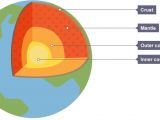Princeton University scientists, together with brainiacs working with other research facilities, have some really big plans for the near future. Long story short, they want to use earthquakes to probe into the anatomy of our planet's mantle and create a 3D map revealing its structure.
Just to put things into perspective, it must be said that Earth's mantle measures about 1,800 miles (nearly 2,900 kilometers) in thickness. Thus, it ends about 300 times deeper into our planet's core than we humans have ever managed to drill.
It is precisely because current technologies simply aren't advanced enough to directly explore it in detail and thoroughly document its makeup that the Princeton University team and their colleagues plan to use earthquakes to get a better idea of what our planet's mantle looks like.
How earthquakes can help scientific research
Whenever an earthquake strikes, so-called seismic waves are produced. As explained by scientists, seismic waves are essentially waves of energy. The more powerful the earthquake that produces them is, the greater they are and the further they can travel.
The behavior of seismic waves greatly depends on the nature of the environments they encounter along their way. What this means is that, by studying them, scientists can determine the structure and the makeup of underground environments they cannot directly reach and study.
As part of their work, the Princeton University scientists and fellow researchers plan to feed information concerning the behavior of seismic waves produced by some 3,000 quakes of magnitude 5.5 and greater into Titan, one of the world's fastest supercomputers.
The specialists expect that, by the end of the year, Titan will have put together at least a sketch of the anatomy of Earth's mantle. Eventually, the supercomputer should produce a 3D map. “The ultimate goal is a 3D map on a global scale,” researcher Jeroen Tromp said in a statement.
What do we care what the Earth looks like on the inside?
The reason why scientists are interested in learning more about our planet's mantle is because this kind of knowledge means being able to make more accurate predictions about future earthquakes and even volcanic eruptions. As some would put it, safety first.
On the other hand, the fact of the matter is that, although way closer to us, we know less about this inner layer of our planet than we know about what lies well beyond our Solar System. Solving this riddle is, in itself, quite an achievement.
“You don't know what it is you are looking for, you are hunting. That is the real challenge, and that is the wonderful part of this project - waiting to see what we will discover,” specialist Jeroen Tromp told the press in an interview.

 14 DAY TRIAL //
14 DAY TRIAL // 
